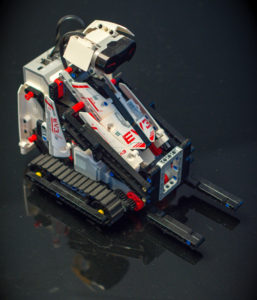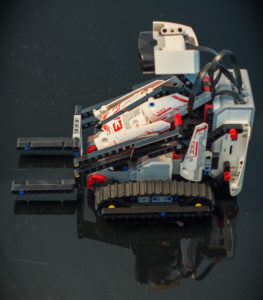
By Dieter
SAP modules such as EWM (Extended Warehouse Management) have long supported stock management, stock administration, and goods flow. Quinaptis now wants to go a step further. With an innovative approach – which doesn’t shy away from a little playfulness – we want SAP systems to better communicate with logistics equipment in order to make them work more efficiently and, above all, more proactively. To achieve this, we purchased a Lego Technic set, which we used to build a warehouse robot. Although it may seem like a game, we want to convert the robot into a stacker crane controlled by SAP. Who said SAP is boring?
Talk to the hardware
SAP was originally designed to better accommodate repetitive work – such as accounting – and to facilitate decisions. It was later extended to other applications, including logistics. SAP modules such as EWM (Extended Warehouse Management) support stock management, stock administration, and goods flow. Quinaptis helps companies implement SAP projects in the logistics sector.
In an automated warehouse, hardware is controlled by the warehouse management system (WMS). This system knows which goods are in stock and where they are located, but, unlike the SAP system, it does not know what and when something is incoming or outgoing. For example, if the WMS controls an Automated Storage and Retrieval System (ASRS), it will not operate until needed. The crane cannot anticipate future demand. But, if we can arrange for the crane to communicate with the SAP planning tools, it can then be used proactively.
In other words, if the ‘look ahead’ factor is built into the system by letting SAP control the hardware, it can prepare goods in advance for future orders during quiet periods.
A second example: an ‘order picker’ travels a route in the warehouse with an automated pallet truck to compile orders. The WMS directs the order picker which boxes to collect and their location, and they are placed on an Automated Guided Vehicle (AGV). Once the AGV is full, it departs for the packaging area and a new one is sent to the picker. If the AGV can talk to the SAP system, then the latter can send a new AGV to the picker in advance, for example when there are only five boxes left to pick. This can save a lot of time.
The condition is that the SAP system can talk to the hardware. At present, this is difficult. Why? The hardware is activated and deactivated by its PLC (Programmable Logic Controller). This controls the motors, the sensors, the aggregates and so on. In order to also understand commands from the EWM module, the PLC and the EWM must be able to communicate, with the SAP software being the interpreter, as it were. As an EWM specialist, Quinaptis is taking up this challenge.
Lego robot as a demo tool
To do this, we bought a Mindstorms EV3 from Lego Technics. This kind of set can be used to build, programme, and control a robot. The last is done by a PLC. We are currently converting the robot into a warehouse robot.
Once we have achieved this, we can scale it up to an ASRS warehouse crane in a kind of mini warehouse. However our intention, when at a more advanced stage, is to connect a robot to the SAP Extended Warehouse Management module (the so-called SCM EWM).
A useful side effect of this approach is that we will learn more about SAP and also warehouse management algorithms. Complying with the traffic regulations in a warehouse, for example.
Playful, but hands-on
With this innovative hands-on approach, Quinaptis can gain experience in a playful yet efficient way. As a result, the risks associated with the actual roll-out to a customer are much smaller, and the time required for implementation can be considerably reduced.
We are building up our knowledge with this project, which will deliver practical benefits to our customers. Some of them have already expressed interest because, thanks to the integration of SAP, EWM, and PLC, the efficiency inside a warehouse can be significantly improved. Currently, the PLC actually performs very simple tasks – after all, it does little more than control the motors – whereas SAP can process a huge amount of data and make intelligent decisions. So, this integration will make it possible to be effectively forward-looking in work. Instead of the hardware standing idle after executing a command, it will be able to continue working on preparing the next scheduled tasks. It can also react intelligently in the event of urgent changes. Our customers, therefore, expect to be able to achieve a very high level of efficiency.
Quinaptis does not shy away from innovation. Our company is taking a progressive approach: we are already thinking of the next step, knowing that it won’t be ready tomorrow. In a warehouse environment, huge amounts of data are generated. And, those who deal with huge amounts of data will also be interested in ‘artificial intelligence’. Deep learning allows us to process gigantic amounts of data to achieve even greater efficiency. But we’re not that far yet. Who knows? Maybe tomorrow we will be ‘playing’ with a Lego Technics robot once again, driven by SAP and A.I.


 Quinaptis bv
Quinaptis bv